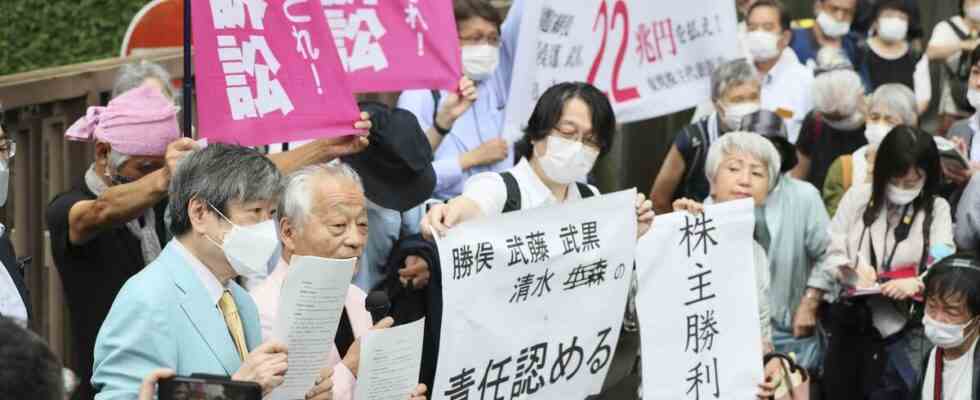This is the first time that former Tepco executives have been sentenced for the Fukushima nuclear disaster in 2011. Japanese justice has condemned the 4 men to record damages of nearly 100 billion euros. This decision is the culmination of legal proceedings launched in 2012 by shareholders of Tepco, the operator of the Fukushima Daiichi power plant, devastated by a huge tsunami on March 11, 2011.
As they left the court, plaintiffs held up banners that read: “Liability recognized” and “Shareholders won”. The damages ordered by the court total more than 13.3 trillion yen, or nearly 97 billion euros, a record for a civil lawsuit in Japan, according to the plaintiffs’ lawyers.
Funds for Tepco and affected residents
“We are aware that [cette somme] goes well beyond their ability to pay,” agreed at a press conference Hiroyuki Kawai, a shareholder lawyer, expecting former Tepco executives to pay what their personal means will allow.
The justice explained that this astronomical amount should be paid to Tepco to meet its costs of dismantling the plant, decontaminating the soil and storing radioactive waste and debris, as well as the compensation to be paid to the inhabitants affected by the the nuclear accident. The shareholders were not seeking compensation for themselves directly but for Tepco, of which they hold part of the capital.
decades of work
The judge found that “the sense of safety and responsibility required for an operator of a nuclear activity was fundamentally lacking”, according to the Japanese public television channel NHK. Shareholders argued that the disaster could have been avoided if Tepco executives had heeded reports advocating preventive measures against a tidal wave, such as building levees and installing electricity systems at higher altitudes. of the plant, located on the edge of the Pacific Ocean in the northeast of Japan.
Three of the plant’s six reactors – Units 1, 2 and 3 – were in service when the tsunami, following a powerful undersea earthquake, swept through. Their cooling systems failed when waves flooded the backup generators, causing the cores of all three reactors to melt. Hydrogen explosions had also occurred in reactors 1, 3 and 4, causing great damage. The work to decontaminate and dismantle the plant is expected to take several more decades.
No criminal charges
“We once again express our most sincere apologies to the people of Fukushima and society in general” for the damage and concerns caused by this disaster, a Tepco spokesperson said on Wednesday, declining to comment on the decision. justice. Since the accident, Tepco has faced numerous legal proceedings, including from residents who were forced to evacuate the area because of the radiation, in sometimes very trying conditions.
In 2019, three former leaders of the operator prosecuted in criminal proceedings by evacuees from the region were acquitted at first instance. The civil parties appealed. These ex-bosses cleared at the time – former Tepco board chairman Tsunehisa Katsumata and former vice-presidents Sakae Muto and Ichiro Takekuro – are among the four convicted on Wednesday, alongside another former company executive, Masataka Shimizu.
Thousands of “related deaths”
If the earthquake and especially the tsunami of March 11, 2011 caused the death of 18,500 people in the northeast of Japan, the nuclear disaster of Fukushima in itself caused no casualties on the spot. However, it is indirectly responsible for several thousand “related deaths”, recognized by the Japanese authorities as deaths due to the deterioration of the living conditions of the many people evacuated from the region.
The Japanese State and Tepco have already been condemned in civil proceedings on several occasions, following numerous complaints from evacuees in collective name. Their fines, however, remained symbolic. Six young plaintiffs also launched a collective legal action in Japan at the end of January to try to have the link, according to them, between their thyroid cancers and their exposure to radiation from the Fukushima plant, near which these people are recognized. were living at the time of the disaster.

